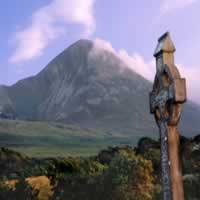COUNTY MAYO - CROAGH PATRICK



Croagh Patrick, which overlooks Clew Bay in County Mayo, is considered the holiest mountain in Ireland. The tradition of pilgrimage to this holy mountain stretches back over 5,000 years from the Stone Age to the present day without interruption. Its religious significance dates back to the time of the pagans, when people are thought to have gathered here to celebrate the beginning of harvest season.
Croagh Patrick is renowned for its Patrician Pilgrimage in honor of Saint Patrick, Ireland`s patron saint. It was on the summit of the mountain that Saint Patrick fasted for forty days in 441 AD and the custom has been faithfully handed down from generation to generation. The Black Bell of Saint Patrick was a highly venerated relic on Croagh Patrick for many years.
The first stop on the pilgrimage is Saint Patrick`s statue erected in 1928 by Reverend Father Patterson with money he collected in America towards the rebuilding of Saint Mary`s Church in Westport. Each year, The Reek, as it is colloquially known, attracts about 1 million pilgrims. On `Reek Sunday`, the last Sunday in July, over 25,000 pilgrims visit the Reek. At the top, there is a modern chapel where mass is celebrated and confessions are heard. Individuals and groups come from all over the world and include pilgrims, hill climbers, historians, archaeologists and nature lovers. The other traditional Pilgrimage days are the last Friday of July which is known locally as `Garland Friday`, and August 15th which is the Feast of the Assumption of Our Lady into Heaven.
Croagh Patrick is 5 miles from the picturesque town of Westport and its conical shape soars majestically above the surrounding countryside. Magnificent views of Clew Bay and the surrounding south Mayo countryside are spectacular from all stages of the ascent of the mountain. It is one of the highest peaks in the West of Ireland. It rises into the sky above County Mayo.
The Archaeology
An archaeological excavation licensed by the National Monuments service commenced on August 2 1994. It discovered evidence of Christian activity but also showed that Croagh Patrick was a place of tremendous importance in the pre-Christian era, as indicated by the discovery of a Celtic hill fort encircling the summit of the mountain. The exciting discovery of a dry stone oratory push back further in time our knowledge of pilgrimage architecture on the summit. It is akin to the Gallarus Oratory in County Kerry and has been radiocarbon dated to between 430 and 890 AD.